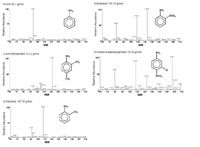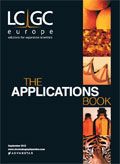Determination and Quantification of Primary Aromatic Amines in Printer Ink
Knauer
There is an increasing public interest in the analysis of aromatic amines since this class of organic compounds includes many carcinogenic substances.
In recent years other sources of aromatic amines apart from tobacco smoke have gained more and more interest, for example, azo dyes (1). Therefore a fast and reliable method for the determination of aromatic amines in dyes like printer ink was developed. Five primary aromatic amines (PAAs) (aniline, 2-anisidine, 3-chloro-4methoxyanline, 2,4-dimethylaniline, o-toluidine) were chosen for this demonstration.
Method Parameters for Full Mass Scan Tests
The mass spectra of single compound standards are shown in Figure 1. The resulting m/z values manifest the fragmentation patterns of the PAAs. For every PAA the highest intensity was detected for the single charged quasi molecule ion [M+H]+. Therefore this mass was chosen for quantification in all cases.
With the calibrated m/z values the extracts of two printer inks were analysed in order to determine PAA composition and concentrations of these five PAAs.

Figure 1: Mass spectra of single standard.
Sample Preparation
Samples were prepared as cold water extracts according to EN 645:1993 from printed paper.
Instrument Configuration
This application was performed on a PLATINblue binary high pressure gradient UHPLC system equipped with degasser, autosampler, column thermostat and MSQ Plus mass detector.

Figure 2: SIC scans of two printer inks (P1 + P2) after sample preparation.
UHPLC Parameters: Column: BlueOrchid 175–1.8 C18, 100 x 2 mm i.d.; Eluent A: water + 0.1% formic acid; Eluent B: methanol + 0.1% formic acid; Gradient: yes (details on request); Flow rate: 0.2 mL/min; Injection volume: 50 µL; Column temperature: 40 °C
MS Detection Parameters: Ionization mode: ESI, positive mode; Needle voltage: 1 kV; Cone voltage: 20 V; Probe temperature: 200 °C
Conclusion
The UHPLC-ESI-MS method presented in this application demonstrates the fast and simultaneous separation, qualification and quantification of five PAAs usually found in printer ink. The limit of detection was in the range between 1 to 5 µg/L (S/N = 3). Only 7 min are required for the analysis of one sample, including a washing step and re-equilibration of the column. Therefore the method is well-suited for routine analyses. Due to the fast separation and low eluent flow rate of this method, only about 1.5 mL of eluent and less than 1 mL of methanol are needed for one run. Thus this method is both economical and environmentally acceptable.
Reference
M.J. Zeilmaker, H.J van Kranen, M.P. van Veen and J. Janus, Cancer risk assessment of azo dyes and aromatic amines from tattoo bands, folders of paper, toys, bed clothes, watch straps and ink. Rijksinstituut voor Volksgezondheid en Milieu RIVM, 22-Feb-2000.
KNAUER
Wissenschaftliche Gerätebau Dr. Ing. Herbert Knauer GmbH, Hegauer Weg 38, 14163 Berlin, Germany
tel: +49 30 809727 0 fax: +49 30 801501 0
E-mail: info@knauer.net, Website:www.knauer.net

Troubleshooting Everywhere! An Assortment of Topics from Pittcon 2025
April 5th 2025In this installment of “LC Troubleshooting,” Dwight Stoll touches on highlights from Pittcon 2025 talks, as well as troubleshooting advice distilled from a lifetime of work in separation science by LCGC Award winner Christopher Pohl.
This information is supplementary to the article “Accelerating Monoclonal Antibody Quality Control: The Role of LC–MS in Upstream Bioprocessing”, which was published in the May 2025 issue of Current Trends in Mass Spectrometry.



















